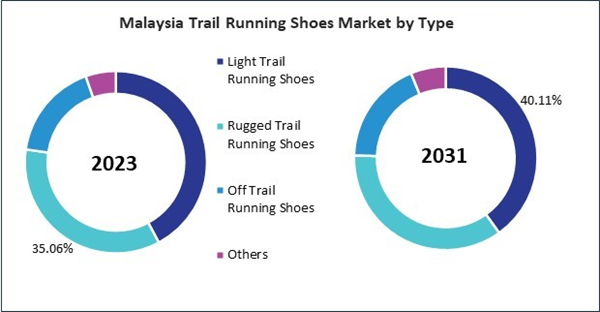Rugged trail running shoes are a specialized segment within the trail running shoes market, tailored for runners who tackle challenging and technical terrains. These shoes are characterized by their robust construction, designed to withstand rugged environments like rocky trails, steep ascents, and unpredictable surfaces. They typically feature durable materials such as reinforced uppers and protective overlays to shield against abrasions and impact. Thus, in India, 1.19 million units of Rugged trail running shoes were utilized in 2023.
The China market dominated the Asia Pacific Trail Running Shoes Market by Country in 2023, and is forecast to continue being a dominant market till 2031; thereby, achieving a market value of $818.5 million by 2031. The Japan market is registering a CAGR of 5.2% during (2024 - 2031). Additionally, The India market would showcase a CAGR of 6.4% during (2024 - 2031).
Mental well-being is another critical aspect of health that trail running impacts positively. The impact of spending time in nature and away from the clamor and bustle of urban life on mental health can be profound. Trail running provides peace and tranquility, reducing stress levels and promoting mental clarity. The body's natural mood elevators, endorphins, are also stimulated by the natural environment and physical exertion, resulting in an enhanced sense of well-being and mood. Many trail runners report feeling a deep connection with nature and experiencing a meditative state while running, contributing to better mental health.
The demand for footwear that offers the requisite support and protection for trail running has increased as a result of the desire to maintain an active lifestyle and capitalize on these health benefits. Trail running shoes are specifically designed to cater to the unique demands of this activity. They offer enhanced grip, durability, and stability, essential for navigating rugged terrains. The shoes also have reinforced toe caps and rock plates to shield runners from sharp rocks and debris. Proper cushioning and arch support prevent injuries and ensure comfort during long runs.
Social media platforms in South Korea also play a significant role in shaping fitness trends. Trail running has gained significant traction on these platforms, with influencers showcasing the activity and its benefits. This online exposure inspires others to participate, driving demand for trail running shoes as essential equipment for exploring the outdoors. South Korea has experienced rapid urbanization in recent decades. This has led to a longing for escape from the densely populated cities and a reconnection with nature. Trail running allows urban dwellers to get outside, explore natural landscapes near their cities, and experience the physical and mental benefits of being in nature. This trend creates a growing market for trail running shoes catering to performance and style. Thus, the aforementioned elements prove that the Asia-Pacific region is witnessing significant growth in the demand for trail running shoes.
List of Key Companies Profiled
- New Balance Athletics, Inc.
- SKECHERS USA, Inc.
- Nike, Inc.
- Reebok International Ltd. (Authentic Brands Group LLC)
- Adidas AG
- La Sportiva S.p.A.
- PUMA SE (Groupe Artémis S.A.)
- Wolverine World Wide, Inc.
- Altra Running (VF Corporation)
- Salomon SAS (Amer Sports Corporation)
Market Report Segmentation
By Sales Channel (Volume, Thousand Units, USD Billion, 2020-2031)- Offline
- Online
- Male
- Female
- Unisex
- Light Trail Running Shoes
- Rugged Trail Running Shoes
- Off Trail Running Shoes
- Others
- China
- Japan
- India
- South Korea
- Singapore
- Malaysia
- Rest of Asia Pacific
Table of Contents
Companies Mentioned
- New Balance Athletics, Inc.
- SKECHERS USA, Inc.
- Nike, Inc.
- Reebok International Ltd. (Authentic Brands Group LLC)
- Adidas AG
- La Sportiva S.p.A.
- PUMA SE (Groupe Artémis S.A.)
- Wolverine World Wide, Inc.
- Altra Running (VF Corporation)
- Salomon SAS (Amer Sports Corporation)









